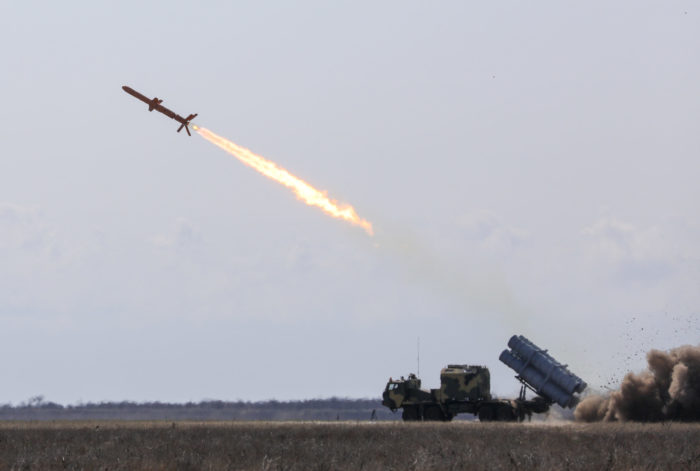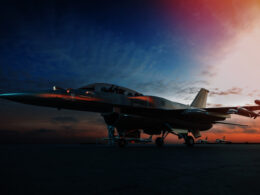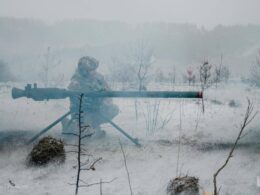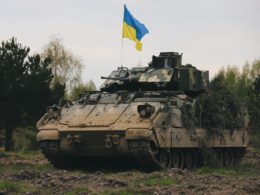The unity of the Ukrainian people in their fight against Russian invaders has become an unexpected trump card of the 2022 war, one of Ukraine’s strongest defense analysts, architect of several defense programs Volodymyr Horbulin and head of the Center for Army, Conversion, and Disarmament Studies Valentyn Badrak conclude in a new book.
"Over the Abyss. 200 Days of the Russian War” offers a review of the reasons for the 2022 large-scale invasion and the ways to end the war faster, Liga.net reported.
The experts believe that Russian President Vladimir Putin began preparing for the invasion in 2018. According to the Kremlin's plan, airborne troops were to execute a Nazi-style blitzkrieg and take Kyiv in three days.
At that moment, Putin was sure that Russia wouldn’t be held accountable for aggression, as the West didn’t act tough to the annexation of Crimea.
But Ukraine’s official policy towards its army also did its part to embolden Putin to implement a lightning-war strategy.
"Neither of the two Ukrainian presidents -- Poroshenko and Zelensky – prepared for war. The 300,000 people in the army reserve who went through military service (during 2014-2022 years) could become a significant force. However, there were no signs that the government began cooperation with them."
Ukrainian political and military officials did not prioritize financing the army during eight years of Russia’s semi-frozen war in the east of the country after 2014. For instance, peaceful Poland spent $12 billion on its military in 2021. Ukraine, which fought with big Russia - allocated only $5 billion, Horbulin and Badrak explain in the book.
At the start of 2022, Ukraine received few deliveries of even such tactical weapons as ATGMs (anti-tank guided missile systems), and other modern weapons were coming in as single purchases only, purchases of small batches, or just the start of production.
“Despite local achievements in strengthening the defense potential, the construction of a powerful army as an institution of deterrence of the Russian Federation did not happen," the book writes.
Consequently, Ukraine entered 2022 far less prepared for war than Russia.
Russia's failed blitzkrieg
Due to the efforts of the Territorial Defense, unexpected mosquito strategy, western support, and resilience of the Ukrainian people, the Russian blitzkrieg failed.
Heroic territorial defense units, mainly consisting of light infantry, assisted police in evacuating civilians, patrolling highways, and eliminating subversive and intelligence groups.
Created in three days, Ukraine’s territorial defense ruined Russian plans to capture Kyiv
From the first hours of the invasion, the Ukrainian forces managed to keep control over the territory by executing mosquito strategies. In this military tactic, soldiers conducted fire from weapons designed to be readily carried and used and inflict maximum damage such as Javelin anti-tank guided munitions and Stinger man-portable air-defense systems.
As a result, the Russian Army became an easy target for Ukraine's mobile combat units.
International support for Ukraine's defense and the strength of the Ukrainian people were the two biggest surprises for the Kremlin. However, the former did not come immediately.
In March, the West was still giving Ukraine exclusively tactical weapons such as Javelins and Stingers, while it required weapons systems that would be able to strike Russian equipment at large distances. Because it lacked this ability, Russia was able to capture and hold the landbridge to Crimea on 21 March.
And then Western policymakers started understanding that Ukraine could win the war.
"If February showed that Ukrainians are capable of resistance, March became a key milestone for changing the global outlook. This month convinced observers that Ukraine is capable of winning... It was in March that Western analysts began to think that Russia will inevitably be defeated."
Western policymakers ultimately shifted their doubts to faith in victory after Ukraine’s military successes:
- the destruction of the cruiser ship Moskva ("When on April 13, the Armed Forces of Ukraine successfully used the coastal missile system Neptune, sinking the flagship of the Russian Black Sea Fleet, Western partners were finally convinced: Ukraine knows how to fight and is determined to win. It was then that... the partners' readiness to really rearm Ukraine appeared.")
- the bombing of the Saky airfield in occupied Crimea. ("Ukraine’s Army actually destroyed a military airfield at a distance of up to 230 km. It was the first blow to [Russia’s] operational and tactical depth... After that, Putin's Kremlin had to realize that the Armed Forces of Ukraine will continue to destroy the invading groups.")
"Ukraine has proven its capability to implement any scenario of ending the war," the book’s authors write. Namely, there are two such scenarios:
"It can either ‘break the neck’ of [Putin’s] regime, or give Putin the opportunity to better prepare for a new big, even more, destructive and more bloody war. And allow him to take over half of Europe - because that is the dictator's agenda."
That is why Ukraine considers only one way to finish the war - to win over Russia on the battlefield, the military experts believe.
This is why now is the best time to stop Putin.
How can Ukraine win the war faster?
The authors of "Over the Abyss. 200 Days of the Russian War” are convinced that Ukraine’s victory over Russia could be achieved through international support and military aid.
However, without the West’s political will, the war can stretch out for years.
"It is quite possible that as a result of the active hot stage of the war, it will be replaced by the same stage of low-intensity hostilities as during 2014-2022. Is it possible to defeat the Moscow dictator’s regime in this case? It is possible and necessary. But only if the whole Western world will join in, with its sanctions, restrictions, and complete political isolation of Putin. And also if all the mistakes of the last eight years are taken into account - in the field of guarantees and further rearmament of Ukraine itself."
The West’s indecisiveness has already allowed Putin to recover after his February failure:
“The ‘collective West’ simply did not dare to give Ukraine the opportunity to send Putin's criminal regime after his [Moskva cruiser] ship. [...] Nuclear blackmail was a significant factor influencing the slow change of positions of the leaders of France, Germany, Italy, and the United States itself. [...] The West was unsure whether it should put Putin on trial or call him, and the bloody dictator liked it."
"The world has already brought up the Hitler of the 21st century, in the form of Putin with a saved face," the authors write.
This is why designating Russia as a state sponsor of terrorism is so important: after several dozen countries of the civilized world will adopt this decision, nobody will call Putin anymore.
How to defeat Putin's regime? The key is US military aid for Ukraine.
To ensure a successful counter-offensive in 2023, Kyiv needs:
- ATACMS long-range missiles that can reach targets up to 300 kilometers
- tanks
- drones
- artillery systems
- and 2,000 missiles for HIMARS.
“As long as Russian capabilities exceed the Ukrainian Army’s capabilities in striking targets by 20 times, this war can last for years," the experts say.
However, “Ukraine’s key guarantee is not in foreign capitals but in its own.”
It should not rely solely on western partners. It needs to boost its domestic weapons production to reduce dependence on western political decisions and develop its own high-tech defense system – “Because if the war is frozen, western assistance will inevitably fall" and “only Ukrainian solutions in the sphere of security and defense can make Ukraine unshakable."
According to the authors, many of Ukraine’s modern weapons technologies are no worse than Western ones:
“Ukraine has already finished the development of tactical strike drones - both a helicopter that can operate a swarm of drones and a number of loitering munitions, kamikaze drones. It has powerful means of electronic warfare. There are also projects of air defense systems that can be no worse than the US-Norwegian NASAMS."
As well, Ukraine needs to create its own mid-range missiles with a striking distance of 300 km and up. For this, it needs to make a “political decision” to finish works on its 500-km cruise missile.
The 280-km “Neptune” anti-ship missile Ukraine used to sink Moskva should become the base of Ukraine’s missile sword. It can be complemented by the Operational Tactical Missile System Hrim (Sapsan), which Ukrainians developed for Saudia Arabia.
Researcher: Ukraine will build its own long-range missiles. If the West allows.
“A 300 km range missile with the prospect of increasing the range of destruction is a totally realistic project. The country which once developed missiles with a range of 12,000 km is capable of making a modern missile, even with a 12 times smaller range."

Ukraine’s defense potential will be based on:
- Missiles with a potential range of striking the enemy's facilities and infrastructure on its territory with a firing range of 280 to 1000 km - a missile sword with a timeframe of 5 years.
- Missiles designed to intercept enemy missiles and hit airplanes and helicopters (firing range from 30 to 100 km) - the missile shield with a timeframe of 5 years.
- Missile equipment for unmanned aircraft designed to intercept air targets (firing range over 100 km) - part of the missile sword of the future, with a timeframe of 10 years.
If there will be political will, Ukraine will be able to defend itself from Russia in five to eight years: Ukraine’s defense sector can currently produce up to 70-80 missiles with a range of up to 280 km per year.
"The presence in Ukraine of about 2,000 missiles with various ranges will make the aggression of even such a country as Russia impossible. Ukraine could create and produce such a number of missiles within the next five to eight years, given the appropriate political decision."
Related:





